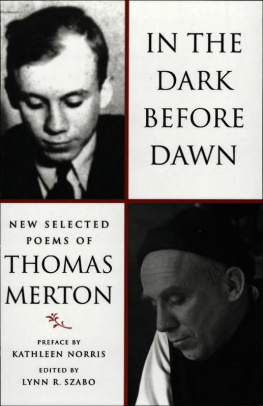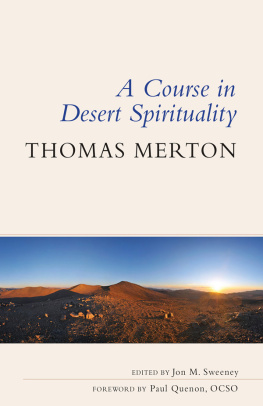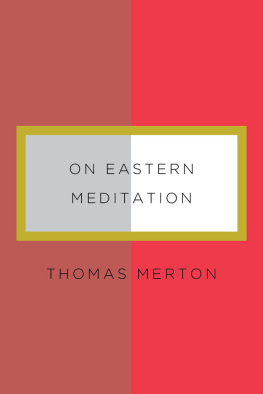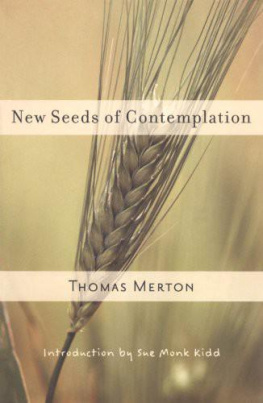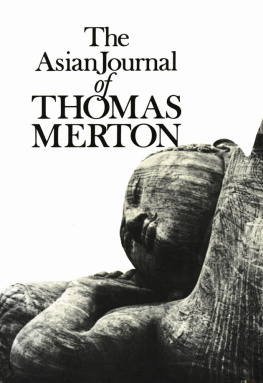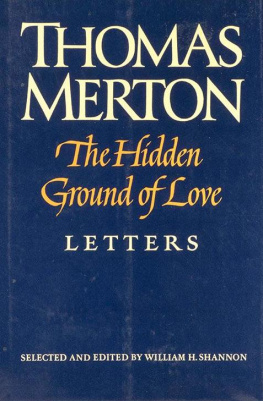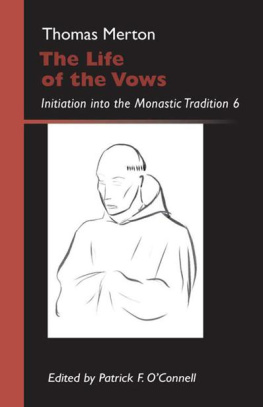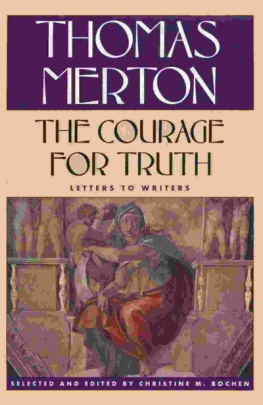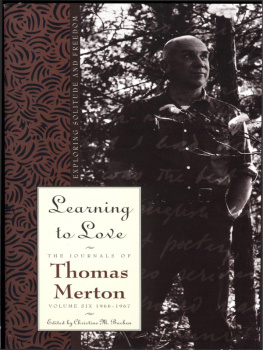Edited by Christine M. Bochen
One thing has suddenly hit methat nothing counts except love and that a solitude that is not simply the wide-openness of love and freedom is nothing. Love and solitude are the one ground of true maturity and freedom . True solitude embraces everything, for it is the fullness of love that rejects nothing and no one, is open to All in All.
For most of his life Thomas Merton kept a journal. To date five volumes of his journals have been published; this is the sixth; a seventh, written in his final years, will appear shortly. Together these journals tell a story that spans more than thirty years in the life of this remarkable monk and writer. Journals take for granted that every day in our life there is something new and different, the young Merton wrote in 1940; a few days later he observed that Every day is different, but also every day is the same. Certainly when he entered the monastery in December 1941, he was able to confirm his intuition of each days sameness and difference. Each monastic day was intentionally meant to be the same as the next structured according to a time-tried schedule of prayer, work, and study that created a framework designed to encourage persistence and fidelity in the monastic vocation even as it discouraged individuality. To that measure of monastic sameness Merton brought a poets eye and a mystics spirit as he looked around and within to notice and record what was different, what set that day apart from the ones that had preceded it in the monastery, on the Kentucky landscape, in the world, and within his heart. Merton attended closely to the ordinariness of life and in doing so opened himself to its unexpected surprises. Compelling descriptions of the commonplace mix with astute, even profound, reflections of one who regularly penetrated below the surface of life to explore its inner depths. Glimpses of the realities of day-today life at Gethsemani are interspersed with visions of what monastic life could be. Acknowledgments of his own shortcomings and sinfulness appear alongside prophetic pronouncements against assaults on human dignity around in the world: against war, racism, totalitarianism, and inhumanity.
This volume, which covers the period from January 2, 1966, to October 8, 1967, contains a mix of the expected and the astounding. What makes this journal strikingly different from the other journals is the story it tells of the well-known monk and writer, enjoying a life of solitude in a hermitage on the grounds of the monastery, who suddenly falls in love and enters upon a tumultuous and unsettling period unlike anything he had ever experienced before. In his journal, Merton writes, with remarkable candidness, of his relationship with M. how they fell in love, what their relationship meant to him, and how their love challenged, threatened, and eventually deepened his experience of solitude. This journal falls into four parts:
JanuaryMarch 1966: a period of relative tranquillity during which his entries capture the ordinariness of his daily life in the hermitage;
AprilSeptember 1966: a time of emotional intensity during which Merton experiences himself as a monk in love; he is initially swept away by his love for M. and her love for him, is then soon disturbed by the contradiction it implies, and finally struggles to reconcile this newly found love with his life of solitude;
SeptemberDecember 1966: a time of recommitment to the life he first chose when he entered the monastery, and now chose again as he reaffirmed his monastic vocation and rededicated himself to a life of solitude aware that his love for M. was as much a fact in his life as was his vocation; and
JanuaryOctober 1967: a time during which Merton settled once again into the routine of life as a hermit and writer.
Also included in the appendices to this volume are A Midsummer Diary for M., which Merton wrote in June 1966, and a substantial portion of Notebook 17, written in JanuaryMarch 1966.
A Journal: January 2, 1966October 8, 1967
When Merton took out a new ledger and began this new journal, he was almost fifty-one years old and had been, for almost a quarter century, a monk of the Abbey of Gethsemani. During those years he had been away from the monastery only a few times. Yet he wrote of the issues facing people in his day with uncanny insight and counted among his friends people all over the world making contacts and maintaining friendships through correspondence. A selection of his letters published in five volumes spans more than two thousand pages. He wrote many books, too numerous to name, though special mention must be made of his best-selling autobiography, The Seven Storey Mountain , published in 1948. During the 1950s and early 1960s, he wrote extensively on contemplation and prayer. Also in the late 1950s and early 1960s, much to the dismay of some of the very readers who had acclaimed his writings on spiritual topics, he began to address the social issues of his day: war, peace, violence, racism, and the abuses of technology. His stand was controversial in the Catholic church of his day, and for a time he was forbidden to publish on the subject of war and peace. Through his writings and example he demonstrated an openness to the wisdom of the worlds religious traditions and readiness to dialogue with individuals whose vision of life and of the holy differed from his own. He had withdrawn from the world to embrace a life of silence and longed for even deeper solitude, yet he was deeply concerned about the world in which he lived. He had chosen a life of solitude, yet he was a warm, affable person one who enjoyed human contact and companionship. When, in 1965, he was given permission to live alone on the monastery grounds, his dream of being a hermit was finally realized. But he was no ordinary hermit, as this journal and the others show. He continued to write letters, receive visitors (only somewhat reluctantly), and write and publish widely: in 1966, Raids on the Unspeakable and Conjectures of a Guilty Bystander; in 1967, Mystics and Zen Masters . During this period, he also wrote a myriad of articles, prefaces, reviews, and poems, while his earlier work was being read in translation in Latin America, Europe, and the Far East.
The entries of January March 1996 show Merton learning how to be in the place for which he had longed during his life as a monk: a place of solitude that was his own. He was settling into the hermitage and enjoying the simple routines of daily life punctuated with prayer, reading, writing, walking, housekeeping, and just being. He was attentive to the ordinary, taking particular delight in his natural environment: observing the stars and constellations in the night sky, watching the ripples of water in his favorite creek, noting the antics of critters (birds, deer, woodchuck) with whom he shared the woods, and celebrating natures springtime awakening. Living close to nature nourished him spiritually. Though he seemed genuinely content in many ways, he was troubled in others. The escalation of the war in Vietnam grieved him; the abbots narrowness irked him and plans for a new monastic foundation tempted him; concerns about his health and the thought of impending surgery disturbed him. Even his newly found solitude weighed heavily on him at times. There were moments when he felt alone, days when he was frustrated, times when he was keenly aware of his own hostility, desperation, and meanness. But he was deeply grateful for the hermitage and the elemental life it made possible: To go out to walk silently in this wood this is a more important and significant means to understanding than a lot of analysis and a lot of reporting on the things of the spirit (March 2, 1966). In the solitude of the hermitage, he was able to see himself more clearly, to realize how muddled and distracted he was, to admit how he was not free. Solitude invited him to let go of all that stood in the way of freedom of involvements, of projects, of all that seems to suggest going somewhere, being someone, having a name and a voice (January 29, 1966). But that was not to be accomplished easily or quickly; he realized that he needed to embrace solitude, again and again. What matters, Merton wrote on January 29, 1966, just two days before his fifty-first birthday, is to love, to be in one place in silence. Read in retrospect those lines seem to auger what lay ahead: an invitation to learn about love, freedom, and solitude in ways he could not possibly have imagined.



